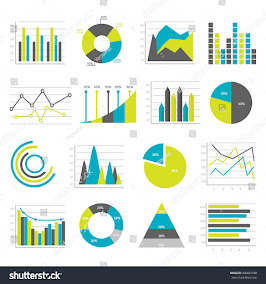Introduction:
The graph is one of the most widely used tools in economics. An economic idea such as cause and effect, supply and demand, or economic cycles can be explained using a graph, which is a visual representation of data. The movement of economic indicators over time is depicted in the graphs. Most economists explain and understand their conclusions using bar graphs, line graphs, and pie charts. Here are a few examples of the various graph types used in economics.
Let's dig deeper into the topic.
The notion of defining the position of a point using coordinates was introduced by French mathematician "Rene " in 1636. The system is known as the Cartesian system of coordinates.
Two different types of variables exist. They function as independent and dependent variables. Dependent variables are often retained on the x-axis, whereas independent variables are typically maintained on the y-axis.
Let XOX' and YOY' be the x- and y- axes, respectively. Here O is the origin. The axes divide the plane into four regions called quadrants. The sign is determined by the quadrant in which it lies.
From the given figure if we have to find a point P in the graph then we have to run two steps and rise 10 steps, which is written as (2,10) called order pair.
Herein the figure, two points (2,10) and (10,2) are plotted in the graph. By joining two points, we get a downward-sloped line. It is also called a negative slope.
Slope:
The slope is obtained from the ratio of rising to the run.
Let's follow the above figure where a change in y = 2 - 10 = - 8
Similarly, change in x = 10 - 2 = 8
Using this formula, slope = -8/8
= - 1
= tan( inverse -1)
= - 45 degrees.
Meaning of magnitude of slope:
- Slope > 0, positive ratio (increase)
- slope = 0, horizontal line
- Slope < 0, negative relationship (downhill)
- Slope = infinite vertical line
- Constant Slope: Straight Line
- Variable Slope: Curved
- Curve maximum and minimum when point slope = 0
Scatter Graph
A style of chart called a scatter graph shows data as a series of points. Each variable's values are represented by dots, which are linked together by lines to demonstrate how they relate to one another.
Why use a scatter plot?
The ability to utilize scatter graphs to clearly depict correlations between variables is one of its major advantages. Scatter plots can also be used to find patterns and trends in your data set. Finally, using this type of chart to compare two or more sets of data simultaneously is simple.
Case Study and Explanation of Demand and Supply Graph
If we use the same graph for the demand curve, then we can rewrite the above information as:
This can be plotted in the graph as shown below.
The psychological meaning of the downward slope graph is when price increases, then quantity demand decreases and vice versa. If you are a rational consumer, then you want to buy at a cheap and best price.
Similarly, the supply curve is upward sloping, which means producers' psychology is when the price rises then the number of output increases. This is because producers are profit-oriented.
According to the graph, the producer delivers Q1 output to the market when the price is P1. Quantity supplied increases from Q1 to Q2 while the price increases from P1 to P2. As a result, the supply curve moves up from point "A" to point "B."
When points are assigned to various scales based on the values of each variable, a graph may be used to show how the relationships between the various variables are related. For instance, in a graph showing the relationship between the inflation rate and the gross domestic product, the size of the points is dispersed among various scales according to how important they are to the overall health of the economy. This makes it simple to observe how one economic component influences another when there are several variables at play.










